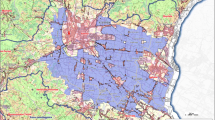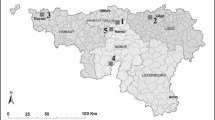Abstract
Two kinds of propagules play a role in Mycosphaerella graminicola dissemination: splash-dispersed pycnidiospores and airborne sexual ascospores. A method based on real-time polymerase chain reaction (PCR) assay and using Burkard spore traps was developed to quantify M. graminicola airborne inoculum. The method was tested for its reliability and applied in a spore trap network over a 2-year period in order to investigate the spatio-temporal distribution of airborne inoculum in Belgium. At four experimental sites, airborne inoculum was detected in both years. A seasonal distribution was observed, with the highest mean daily quantities (up to 351.0 cDNA) trapped in July and with clusters detected from September to April. The first year of trapping, a mean daily quantity of 15.7 cDNA of M. graminicola airborne inoculum was also detected in the air above a building in a city where the spatio-temporal distribution showed a similar pattern to that in the field. Mean daily quantities of up to 60.7 cDNA of airborne inoculum were measured during the cereal stem elongation and flowering stages, suggesting that it contributes to the infection of upper leaves later in the season. Most detection, however, tended to occur between flowering and harvest, suggesting significant production of pseudothecia during that period. Variations in mean daily quantities from 1.0 to 48.2 cDNA were observed between sites and between years in the patterns of airborne inoculum. After stem elongation, the quantities detected at a site were positively correlated with the disease pressure in the field. Quantities trapped at beginning of the growing season were also well correlated with the disease level the previous year. Multiple regressions revealed that some factors partly explain the daily variations of airborne inoculum.







Similar content being viewed by others
References
Altschul, S. F., Gish, W., Miller, W., Myers, E. W., & Lipman, D. J. (1990). Basic local alignment search tool. Journal of Molecular Biology, 215, 403–410.
Bathgate, J. A., & Loughman, R. (2001). Ascospores are a source of inoculum of Phaeosphaeria nodorum, P. avenaria f. sp. avenaria and Mycosphaerella graminicola in Western Australia. Australasian Plant Pathology, 30, 317–322.
Brown, J. S., Kellock, A. W., & Paddick, R. G. (1978). Distribution and dissemination of Mycosphaerella graminicola (Fuckel) Schroeter in relation to the epidemiology of speckled leaf blotch of wheat. Australian Journal of Agricultural Research, 29, 1139–1145.
Burch, M., & Levetin, E. (2002). Effects of meterological conditions on spore plumes. International Journal of Biometeorology, 46, 107–117.
Calderon, C., Ward, E., Freeman, J., Foster, S. J., & McCartney, A. (2002a). Detection of airborne inoculum of Leptosphaeria maculans and Pyrenopeziza brassicae in oilseed rape crops by polymerase chain reaction (PCR) assays. Plant Pathology, 51, 303–310.
Calderon, C., Ward, E., Freeman, J., & McCartney, A. (2002b). Detection of airborne fungal spores sampled by rotating-arm and Hirst-type spore traps using polymerase chain reaction assays. Journal of Aerosol Science, 33, 283–296.
Clinckemaillie, A., Dedeurwaerder, G., Duvivier, M., Moreau, J. M., & Legrève, A. (2010). Presence of airborne inoculum of Mycosphaerella graminicola and occurrence of sexual reproduction during the growing season in Belgium. Phytopathology, 100, S26.
Cordo, C. A., Simon, M. R., Perelló, A. E., & Alippi, H. E. (1999). Spore dispersal of leaf blotch pathogens of wheat (Mycosphaerella graminicola and Septoria tritici). Proceedings of the fifth International Septoria Workshop, 1999, 98–101.
Eriksen, L., & Munk, L. (2003). The occurrence of Mycosphaerella graminicola and its anamorph Septoria tritici in winter wheat during the growing season. European Journal of Plant Pathology, 109, 253–259.
Eyal, Z. (1999). The Septoria tritici and Stagonospora nodorum blotch diseases of wheat. European Journal of Plant Pathology, 105, 629–641.
Eyal, Z., Scharen, A. L., & van Ginkel, M. (1987). The Septoria diseases of wheat: concepts and methods of disease management. Mexico City: CIMMYT.
Fitt, B. D. L., McCartney, H. A., & Walklate, P. J. (1989). The role of rain in dispersal of pathogen inoculum. Annual Review of Phytopathology, 27, 241–270.
Fountaine, J. M., Shaw, M. W., Ward, E., & Fraaije, B. A. (2010). The role of seeds and airborne inoculum in the initiation of leaf blotch (Rhynchosporium secalis) epidemics in winter barley. Plant Pathology, 59, 330–337.
Fraaije, B. A., Cools, H. J., Fountaine, J., Lovell, D. J., Motteram, J., West, J. S., et al. (2005). Role of ascospores in further spread of QoI-resistant cytochrome b alleles (G143A) in field populations of Mycosphaerella graminicola. Phytopathology, 95, 933–941.
Hasnain, S. M. (1993). Influence of meteorological factors in the air spora. Grana, 28, 187–192.
Holb, I. J., Heijne, B., Withagen, J. C. M., & Jeger, M. J. (2004). Dispersal of Venturia inaequalis ascospores and disease gradients from a defined inoculum source. Journal of Phytopathology, 152, 639–646.
Hunter, T., Coker, R. R., & Royle, D. J. (1999). The teleomorph stage, Mycosphaerella graminicola, in epidemics of Septoria tritici blotch on winter wheat in the UK. Plant Pathology, 48, 51–57.
Kema, G. H. J., Verstappen, E. C. P., Todorova, M., & Waalwijk, C. (1996). Successful crosses and molecular tetrad and progeny analyses demonstrate heterothallism in Mycosphaerella graminicola. Current Genetics, 30, 251–258.
King, J. E., Cook, R. J., & Melville, S. C. (1983). A review of Septoria diseases of wheat and barley. Annals of Applied Biology, 103, 345–373.
Lee, S. B., & Taylor, J. W. (1990). Isolation of DNA from fungal mycelium and single spores. In M. A. Innis, D. H. Gelfand, J. J. Sninsky, & T. J. White (Eds.), PCR protocols. A guide to methods and applications (pp. 282–288). San Diego: Academics Press, Inc.
Luo, Y., Ma, Z., Reyes, H. C., Morgan, D., & Michailides, T. J. (2007). Quantification of airborne spores of Monilia fructicola in stone fruit orchards of California using real-time PCR. European Journal of Plant Pathology, 118, 145–154.
Lyon, F. L., Kramer, C. L., & Eversmeyer, M. G. (1983). Variation of airspora in the atmosphere due to weather conditions. Grana, 23, 177–181.
Moreau, J. M., & Maraite, H. (1999). Integration of knowledge on wheat phenology and Septoria tritici epidemiology into a disease risk simulation model validated in Belgium. Aspects of Applied Biology, 55, 1–6.
Palmer, C. L., & Skinner, W. (2002). Mycosphaerella graminicola: latent infection, crop devastation and genomics. Molecular Plant Pathology, 3, 63–70.
Rogers, S. L., Atkins, S. D., & West, J. S. (2009). Detection and quantification of airborne inoculum of Sclerotinia sclerotiorum using quantitative PCR. Plant Pathology, 58, 324–331.
Scott, P. R., Sanderson, F. R., & Benedikz, P. W. (1988). Occurrence of Mycosphaerella graminicola, teleomorph of Septoria tritici, on wheat debris in the UK. Plant Pathology, 37, 285–290.
Selim, S., Roisin-Fichter, C., Andry, J. B., & Bogdanow B. (2011). Accuracy of real-time PCR to study Mycosphaerella graminicola epidemic in wheat: from spore arrival to fungicide efficiency. In N. Thajuddin (Ed.), Fungicides - beneficial and harmful aspects (chap. 12). Intech.
Shaw, M. W., & Royle, D. J. (1989). Airborne inoculum as a major source of Septoria tritici (Mycosphaerella graminicola) infections in winter wheat crops in the UK. Plant Pathology, 38, 45–53.
Shaw, M. W., & Royle, D. J. (1993). Factors determining the severity of epidemics of Mycosphaerella graminicola (Septoria tritici) on winter wheat in the UK. Plant Pathology, 42, 882–899.
Suffert, F., & Sache, I. (2011). Relative importance of different types of inoculum to the establishment of Mycosphaerella graminicola in wheat crops in north-west Europe. Plant Pathology, 60, 878–889.
Suffert, F., Sache, I., & Lannou, C. (2011). Early stages of septoria tritici blotch epidemics of winter wheat: build-up, overseasoning, and release of primary inoculum. Plant Pathology, 60, 166–177.
Trout, C., & Levetin, E. (2001). Correlations of spring spore concentrations and meteorological conditions in Tulsa, Oklahoma. International Journal of Biometeorology, 45, 64–74.
Williams, R. H., Ward, E., & McCartney, H. A. (2001). Methods for integrated air sampling and DNA analysis for detection of airborne fungal spores. Applied and Environmental Microbiology, 67, 2453–2459.
Zhan, J., Mundt, C. C., & McDonald, B. A. (1998). Measuring immigration and sexual reproduction in field populations of Mycosphaerella graminicola. Phytopathology, 88, 1330–1337.
Acknowledgments
This research was supported by the Service Public de Wallonie, Direction générale opérationnelle Agriculture, Ressources naturelles et Environnement. The corresponding authors are indebted to Dr. Ir. Viviane Planchon, Department of Agriculture and Natural Environment Department of Walloon Agricultural Research Centre, Belgium and Dr. Ir. Jerome Ambroise, Center of Applied Molecular Technologies, Institut de Recherche Expérimentale et Clinique, Université catholique de Louvain, Belgium for support in statistical analysis. The authors thank Gérald Marchal, Marie-Eve Renard and Viviane Van Hese for technical assistance.
Author information
Authors and Affiliations
Corresponding authors
Additional information
Maxime Duvivier & Géraldine Dedeurwaerder contributed equally to this work.
Rights and permissions
About this article
Cite this article
Duvivier, M., Dedeurwaerder, G., De Proft, M. et al. Real-time PCR quantification and spatio-temporal distribution of airborne inoculum of Mycosphaerella graminicola in Belgium. Eur J Plant Pathol 137, 325–341 (2013). https://doi.org/10.1007/s10658-013-0245-0
Accepted:
Published:
Issue Date:
DOI: https://doi.org/10.1007/s10658-013-0245-0




